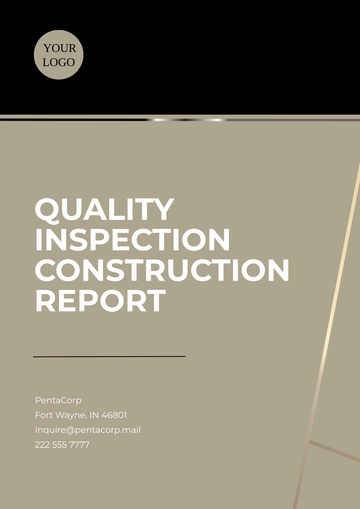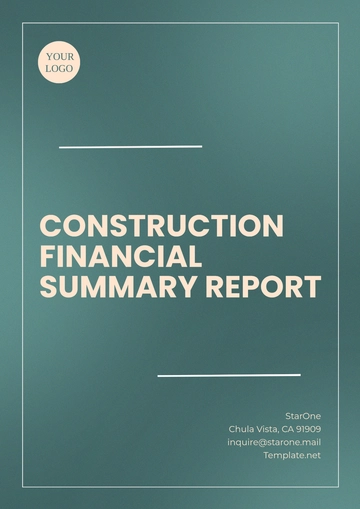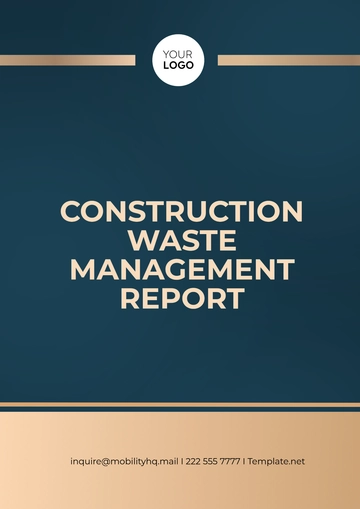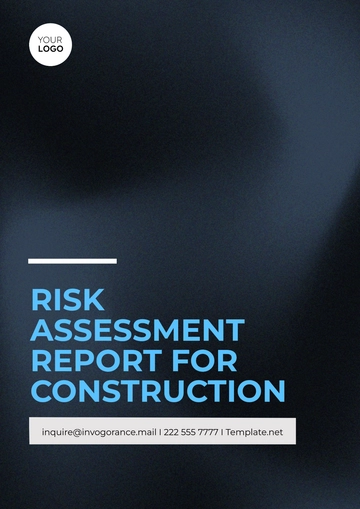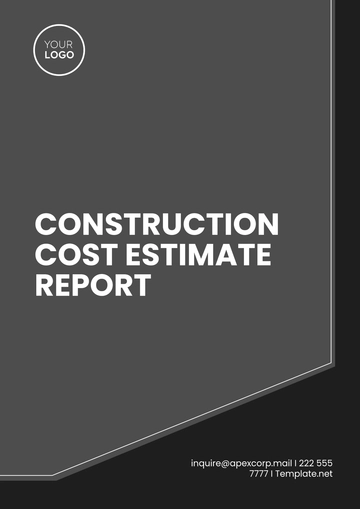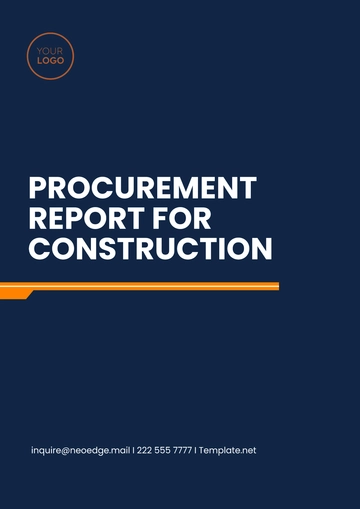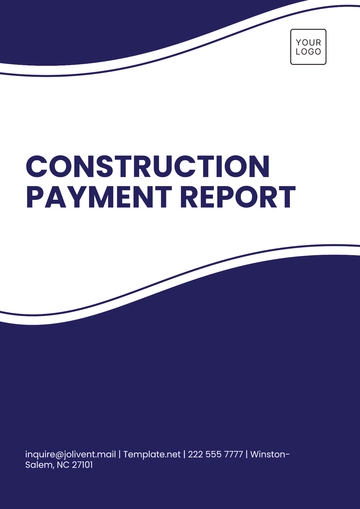Free Construction Project Report

I. Executive Summary
The Construction Project Report provides a comprehensive overview of the progress, milestones achieved, and challenges encountered during the construction of the Downtown Office Complex. This report aims to keep stakeholders informed about the project's status and ensure transparency in project management.
II. Project Overview
A. Project Details
Detail | Information |
|---|---|
Project Title | Downtown Office Complex |
Project Owner | [YOUR COMPANY NAME] |
Project Manager | [YOUR NAME] |
Project Start Date | January 15, 2050 |
Expected Completion Date | December 20, 2051 |
B. Project Scope
The scope of the project includes the construction of a 20-story office building with modern amenities, green spaces, and underground parking facilities. The total built-up area is 300,000 square feet. Key features include:
Open-plan office spaces
High-efficiency HVAC system
Smart building technology integration
LEED Platinum certification for sustainability
Rooftop garden and recreational area
Retail spaces on the ground floor
III. Progress Update
A. Milestones Achieved
Milestone | Completion Date |
|---|---|
Site preparation completed | March 1, 2050 |
Foundation laid and inspected | April 15, 2050 |
Structural framing completed | September 30, 2050 |
Roofing installation finalized | December 15, 2050 |
Exterior finishing commenced | January 20, 2051 |
B. Work in Progress
Activity | Status |
|---|---|
Interior electrical installations | Ongoing |
Plumbing installations | Ongoing |
HVAC system installation | In progress |
Interior drywall and painting | Underway |
Landscape design and implementation | Initiated |
C. Challenges and Mitigation
Challenge | Mitigation Strategy |
|---|---|
Delay in material delivery due to supply chain disruptions | Expedited ordering and alternative sourcing strategies implemented. Coordination with suppliers to prioritize critical materials. |
Adverse weather conditions affecting outdoor construction activities | Revised construction schedule and allocation of resources to indoor tasks. Use of temporary shelters to continue work during adverse weather. |
IV. Quality Assurance
A. Inspection Reports
Inspection Date | Inspected By | Inspection Focus |
|---|---|---|
January 15, 2051 | [INSPECTOR'S NAME] | Foundation work |
February 15, 2051 | [INSPECTOR'S NAME] | Structural integrity of framework |
March 15, 2051 | [INSPECTOR'S NAME] | Roofing and exterior finishing |
B. Quality Control Measures
Stringent quality control procedures implemented to maintain high standards of workmanship.
Use of high-quality construction materials and certified suppliers.
Immediate rectification of identified defects to avoid rework and delays.
V. Stakeholder Communication
A. Project Meetings
Meeting Frequency | Participants | Focus |
|---|---|---|
Weekly | Project management team, stakeholders | Discuss progress, issues, and action plans |
Monthly | Project management team, client | Review project status, budget, and schedule |
B. Client Communication
Regular updates provided to the client regarding project status, budget, and schedule.
Client feedback incorporated into decision-making processes to ensure satisfaction and alignment with expectations.
VI. Financial Status
A. Budget Allocation
Category | Amount Allocated | Expenditures to Date | Remaining Budget |
|---|---|---|---|
Total Project Budget | $150,000,000 | $90,000,000 | $60,000,000 |
Construction Materials | $50,000,000 | $30,000,000 | $20,000,000 |
Labor | $70,000,000 | $42,000,000 | $28,000,000 |
Contingency | $30,000,000 | $18,000,000 | $12,000,000 |
B. Forecast
Based on the current progress and expenditures, the forecasted cost to complete the project is estimated to be within the allocated budget.
VII. Health and Safety
A. Safety Measures
Comprehensive safety protocols established and enforced on-site to prevent accidents and injuries.
Safety training provided to all personnel involved in the project.
B. Incident Reports
Incident Type | Date | Action Taken |
|---|---|---|
Minor slip incident | February 1, 2051 | Investigation and corrective measures implemented. Safety briefing conducted. |
VIII. Environmental Impact
A. Environmental Compliance
Compliance with environmental regulations and sustainability standards ensured throughout the project lifecycle.
Measures taken to minimize environmental footprint and mitigate any adverse effects on the surrounding ecosystem.
B. Waste Management
Waste Type | Management Strategy |
|---|---|
Construction debris | Segregation and recycling |
Hazardous materials | Safe disposal per regulations |
IX. Next Steps
A. Immediate Action Items
Action Item | Deadline | Responsible Party |
|---|---|---|
Expedite delivery of critical materials | June 15, 2051 | Procurement Team |
Monitor weather forecasts | Ongoing | Site Manager |
Conduct regular site inspections | Weekly | Quality Control Team |
B. Future Milestones
Milestone | Expected Date |
|---|---|
Interior finishing and fixture installations | September 30, 2051 |
Final inspections and certifications | November 30, 2051 |
Handover to the client | December 20, 2051 |
X. Conclusion
The Construction Project Report provides a comprehensive overview of the project's progress, challenges, and mitigation strategies. Despite obstacles, the project remains on track for timely completion, thanks to proactive management and effective collaboration among stakeholders.
- 100% Customizable, free editor
- Access 1 Million+ Templates, photo’s & graphics
- Download or share as a template
- Click and replace photos, graphics, text, backgrounds
- Resize, crop, AI write & more
- Access advanced editor
Elevate your construction project management with Template.net's Construction Project Report Template. This customizable and editable template offers a seamless solution for organizing and presenting project data. Simplify your reporting process and impress stakeholders effortlessly. With the AI Editor Tool, tailor reports to your specific needs. Streamline your project documentation and ensure clarity.
You may also like
- Sales Report
- Daily Report
- Project Report
- Business Report
- Weekly Report
- Incident Report
- Annual Report
- Report Layout
- Report Design
- Progress Report
- Marketing Report
- Company Report
- Monthly Report
- Audit Report
- Status Report
- School Report
- Reports Hr
- Management Report
- Project Status Report
- Handover Report
- Health And Safety Report
- Restaurant Report
- Construction Report
- Research Report
- Evaluation Report
- Investigation Report
- Employee Report
- Advertising Report
- Weekly Status Report
- Project Management Report
- Finance Report
- Service Report
- Technical Report
- Meeting Report
- Quarterly Report
- Inspection Report
- Medical Report
- Test Report
- Summary Report
- Inventory Report
- Valuation Report
- Operations Report
- Payroll Report
- Training Report
- Job Report
- Case Report
- Performance Report
- Board Report
- Internal Audit Report
- Student Report
- Monthly Management Report
- Small Business Report
- Accident Report
- Call Center Report
- Activity Report
- IT and Software Report
- Internship Report
- Visit Report
- Product Report
- Book Report
- Property Report
- Recruitment Report
- University Report
- Event Report
- SEO Report
- Conference Report
- Narrative Report
- Nursing Home Report
- Preschool Report
- Call Report
- Customer Report
- Employee Incident Report
- Accomplishment Report
- Social Media Report
- Work From Home Report
- Security Report
- Damage Report
- Quality Report
- Internal Report
- Nurse Report
- Real Estate Report
- Hotel Report
- Equipment Report
- Credit Report
- Field Report
- Non Profit Report
- Maintenance Report
- News Report
- Survey Report
- Executive Report
- Law Firm Report
- Advertising Agency Report
- Interior Design Report
- Travel Agency Report
- Stock Report
- Salon Report
- Bug Report
- Workplace Report
- Action Report
- Investor Report
- Cleaning Services Report
- Consulting Report
- Freelancer Report
- Site Visit Report
- Trip Report
- Classroom Observation Report
- Vehicle Report
- Final Report
- Software Report










